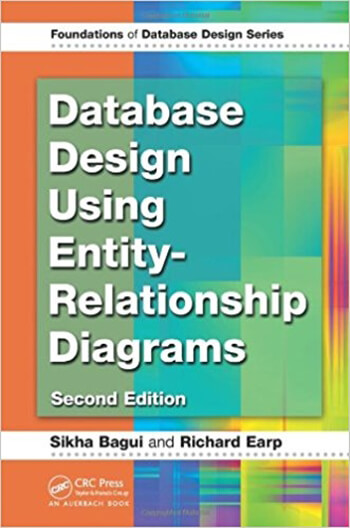This is completed downloadable of Database Design Using Entity Relationship Diagrams 2nd Bagui Solution Manual

Product Details:
- ISBN-10 : 1439861765
- ISBN-13 : 978-1439861769
- Author:
Essential to database design, entity-relationship (ER) diagrams are known for their usefulness in mapping out clear database designs. They are also well-known for being difficult to master. With Database Design Using Entity-Relationship Diagrams, Second Edition, database designers, developers, and students preparing to enter the field can quickly learn the ins and outs of ER diagramming.
Building on the success of the bestselling first edition, this accessible text includes a new chapter on the relational model and functional dependencies. It also includes expanded chapters on Enhanced Entity Relationship (EER) diagrams and reverse mapping. It uses cutting-edge case studies and examples to help readers master database development basics and defines ER and EER diagramming in terms of requirements (end user requests) and specifications (designer feedback to those requests).
- Describes a step-by-step approach for producing an ER diagram and developing a relational database from it
- Contains exercises, examples, case studies, bibliographies, and summaries in each chapter
- Details the rules for mapping ER diagrams to relational databases
- Explains how to reverse engineer a relational database back to an entity-relationship model
- Includes grammar for the ER diagrams that can be presented back to the user
The updated exercises and chapter summaries provide the real-world understanding needed to develop ER and EER diagrams, map them to relational databases, and test the resulting relational database. Complete with a wealth of additional exercises and examples throughout, this edition should be a basic component of any database course. Its comprehensive nature and easy-to-navigate structure makes it a resource that students and professionals will turn to throughout their careers.
Table of Content:
- Front Cover (1/2)
- Front Cover (2/2)
- Contents (1/3)
- Contents (2/3)
- Contents (3/3)
- Preface
- Acknowledgments
- Introduction
- Chapter 1: Data, Databases, and the Software Engineering Process (1/2)
- Chapter 1: Data, Databases, and the Software Engineering Process (2/2)
- Chapter 2: Data and Data Models (1/5)
- Chapter 2: Data and Data Models (2/5)
- Chapter 2: Data and Data Models (3/5)
- Chapter 2: Data and Data Models (4/5)
- Chapter 2: Data and Data Models (5/5)
- Chapter 3: The Relational Model and Functional Dependencies (1/7)
- Chapter 3: The Relational Model and Functional Dependencies (2/7)
- Chapter 3: The Relational Model and Functional Dependencies (3/7)
- Chapter 3: The Relational Model and Functional Dependencies (4/7)
- Chapter 3: The Relational Model and Functional Dependencies (5/7)
- Chapter 3: The Relational Model and Functional Dependencies (6/7)
- Chapter 3: The Relational Model and Functional Dependencies (7/7)
- Chapter 4: The Basic ER Diagram : A Data Modeling Schema (1/7)
- Chapter 4: The Basic ER Diagram : A Data Modeling Schema (2/7)
- Chapter 4: The Basic ER Diagram : A Data Modeling Schema (3/7)
- Chapter 4: The Basic ER Diagram : A Data Modeling Schema (4/7)
- Chapter 4: The Basic ER Diagram : A Data Modeling Schema (5/7)
- Chapter 4: The Basic ER Diagram : A Data Modeling Schema (6/7)
- Chapter 4: The Basic ER Diagram : A Data Modeling Schema (7/7)
- Chapter 5: Beyond the First Entity Diagram (1/5)
- Chapter 5: Beyond the First Entity Diagram (2/5)
- Chapter 5: Beyond the First Entity Diagram (3/5)
- Chapter 5: Beyond the First Entity Diagram (4/5)
- Chapter 5: Beyond the First Entity Diagram (5/5)
- Chapter 6: Extending Relationships/Structural Constraints (1/10)
- Chapter 6: Extending Relationships/Structural Constraints (2/10)
- Chapter 6: Extending Relationships/Structural Constraints (3/10)
- Chapter 6: Extending Relationships/Structural Constraints (4/10)
- Chapter 6: Extending Relationships/Structural Constraints (5/10)
- Chapter 6: Extending Relationships/Structural Constraints (6/10)
- Chapter 6: Extending Relationships/Structural Constraints (7/10)
- Chapter 6: Extending Relationships/Structural Constraints (8/10)
- Chapter 6: Extending Relationships/Structural Constraints (9/10)
- Chapter 6: Extending Relationships/Structural Constraints (10/10)
- Chapter 7: The Weak Entity (1/5)
- Chapter 7: The Weak Entity (2/5)
- Chapter 7: The Weak Entity (3/5)
- Chapter 7: The Weak Entity (4/5)
- Chapter 7: The Weak Entity (5/5)
- Chapter 8: Further Extensions for ER Diagrams with Binary Relationships (1/8)
- Chapter 8: Further Extensions for ER Diagrams with Binary Relationships (2/8)
- Chapter 8: Further Extensions for ER Diagrams with Binary Relationships (3/8)
- Chapter 8: Further Extensions for ER Diagrams with Binary Relationships (4/8)
- Chapter 8: Further Extensions for ER Diagrams with Binary Relationships (5/8)
- Chapter 8: Further Extensions for ER Diagrams with Binary Relationships (6/8)
- Chapter 8: Further Extensions for ER Diagrams with Binary Relationships (7/8)
- Chapter 8: Further Extensions for ER Diagrams with Binary Relationships (8/8)
- Chapter 9: Ternary and Higher-Order ER Diagrams (1/5)
- Chapter 9: Ternary and Higher-Order ER Diagrams (2/5)
- Chapter 9: Ternary and Higher-Order ER Diagrams (3/5)
- Chapter 9: Ternary and Higher-Order ER Diagrams (4/5)
- Chapter 9: Ternary and Higher-Order ER Diagrams (5/5)
- Chapter 10: The Enhanced Entity Relationship (EER) Model (1/7)
- Chapter 10: The Enhanced Entity Relationship (EER) Model (2/7)
- Chapter 10: The Enhanced Entity Relationship (EER) Model (3/7)
- Chapter 10: The Enhanced Entity Relationship (EER) Model (4/7)
- Chapter 10: The Enhanced Entity Relationship (EER) Model (5/7)
- Chapter 10: The Enhanced Entity Relationship (EER) Model (6/7)
- Chapter 10: The Enhanced Entity Relationship (EER) Model (7/7)
- Chapter 11: Relational Mapping and Reverse Engineering ER/EER Diagrams (1/5)
- Chapter 11: Relational Mapping and Reverse Engineering ER/EER Diagrams (2/5)
- Chapter 11: Relational Mapping and Reverse Engineering ER/EER Diagrams (3/5)
- Chapter 11: Relational Mapping and Reverse Engineering ER/EER Diagrams (4/5)
- Chapter 11: Relational Mapping and Reverse Engineering ER/EER Diagrams (5/5)
- Chapter 12: A Brief Overview of the Barker/Oracle-Like Model (1/4)
- Chapter 12: A Brief Overview of the Barker/Oracle-Like Model (2/4)
- Chapter 12: A Brief Overview of the Barker/Oracle-Like Model (3/4)
- Chapter 12: A Brief Overview of the Barker/Oracle-Like Model (4/4)
- Glossary (1/2)
- Glossary (2/2)
- Back Cover





